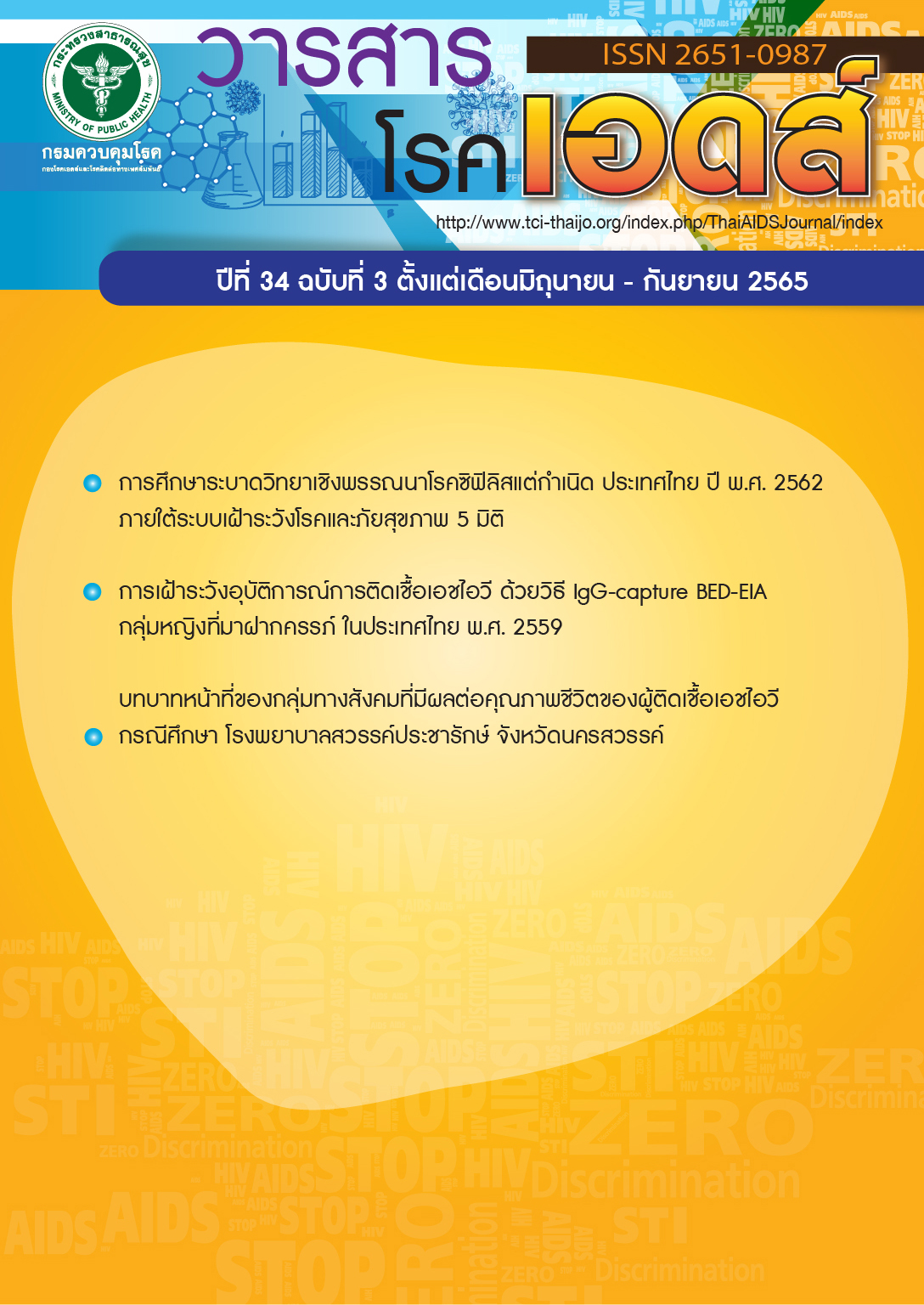การเฝ้าระวังอุบัติการณ์การติดเชื้อเอชไอวี ด้วยวิธี IgG-capture BED-EIA กลุ่มหญิงที่มาฝากครรภ์ ในประเทศไทย พ.ศ. 2559
DOI:
https://doi.org/10.14456/taj.2022.12คำสำคัญ:
อุบัติการณ์การติดเชื้อเอชไอวี, การติดเชื้อเอชไอวีรายใหม่, หญิงที่มาฝากครรภ์บทคัดย่อ
การเฝ้าระวังอุบัติการณ์การติดเชื้อเอชไอวี กลุ่มหญิงที่มาฝากครรภ์ เริ่มดำเนินการเฝ้าระวังโดยอาศัยผลการตรวจทางห้องปฏิบัติการด้วยวิธี IgG-capture BED-EIA ตั้งแต่ปี พ.ศ. 2547 มีวัตถุประสงค์เพื่อคาดประมาณอุบัติการณ์การติดเชื้อเอชไอวี ด้วยวิธี Immunoglobulin G (IgG) capture BED enzyme Immunoassay (BED-CEIA) ในหญิงที่มาฝากครรภ์ การเก็บข้อมูลดำเนินการด้วยวิธีการสำรวจซ้ำ (Repeated survey) ในประชากรกลุ่มเดิม (Same dynamic population) โดยเก็บตัวอย่างเลือดจากหญิงที่มาฝากครรภ์และตรวจหาการติดเชื้อเอชไอวีด้วยวิธีการตรวจหาแอนติบอดีตามวิธีการมาตรฐาน และนำซีรั่มที่เหลือของหญิงที่มาฝากครรภ์ที่ได้รับการวินิจฉัยพบการติดเชื้อเอชไอวีส่งตรวจหาการติดเชื้อเอชไอวีรายใหม่ด้วยวิธี Immunoglobulin G (IgG) capture BED enzyme Immunoassay (BED-CEIA) ที่สถาบันวิจัยวิทยาศาสตร์สาธารณสุข กรมวิทยาศาสตร์ การแพทย์
ผลการศึกษาพบว่า จำนวนหญิงที่มาฝากครรภ์ในช่วงเวลาที่ทำการศึกษาทั้งสิ้น 36,614 ราย ตรวจพบการติดเชื้อเอชไอวี 183 ราย ความชุกการติดเชื้อเอชไอวี ร้อยละ 0.43 เป็นผู้ติดเชื้อเอชไอวีรายใหม่ 23 ราย อุบัติการณ์การติดเชื้อเอชไอวีในกลุ่มหญิงที่มาฝากครรภ์เท่ากับร้อยละ 0.16 ซึ่งมีแนวโน้มลดลงจากปี พ.ศ. 2553 ที่ยังมีการติดเชื้อเอชไอวีรายใหม่ตลอดเวลา สอดคล้องกับข้อมูลการคาดประมาณในปี พ.ศ. 2558 มีผู้ติดเชื้อเอชไอวีรายใหม่ประมาณ 6,900 ราย แสดงให้เห็นว่าสถานการณ์การระบาดของเอชไอวี/เอดส์ในประเทศไทยยังพบการติดเชื้อเอชไอวีรายใหม่ตลอดเวลาถึงแม้จะลดลงในปี พ.ศ. 2553 แต่ยังไม่บรรลุเป้าหมายลดการติดเชื้อเอชไอวีรายใหม่ 2 ใน 3 หรือเป้าหมายในการประชุมระดับโลกที่กำหนดให้การติดเชื้อเอชไอวีรายใหม่ลดลงร้อยละ 50
Downloads
เอกสารอ้างอิง
Division of Epidemiology, Department of Disease Control. Guidelines for HIV Incidence surveillance, 2008. [Internet]. Nonthaburi: Division of Epidemiology; 2008 [cited 2022 Feb 1]. 55p. Available from: http://aidsboe.moph.go.th/app/bookup/uploads/2020-03-06277284637.pdf (in Thai)
Division of Epidemiology, Department of Disease Control. State of the Art of HIV/AIDS surveillance and its status in Thailand; 2010. [Internet]. Nonthaburi: Division of Epidemiology; 2020 [cited 2022 Feb 1]. 109 p. Available from: http://aidsboe.moph.go.th/app/bookup/uploads/2020-03-061548560099.pdf (in Thai)
Wang R, Lagakos SW. On the use of adjusted cross-sectional estimators of HIV incidence. J Acquir Immune Defic Syndr [Internet]. 2009 Dec [cited 2021 Nov 1];52(5):538-47. Available from: https://pubmed.ncbi.nlm.nih.gov/19881357/
Centers for Disease Control and Prevention. Interim recommendations for the use of the BED capture enzyme immunoassay for incidence estimation and surveillance [Internet]. Georgia: Centers for Disease Control and Prevention; 2006 Nov 21 [cited 2014 May 13]. 5 p. Available from: http://www.cdc.gov/globalAIDS/docs/surveillance/Interim Recommendations for the use of the BED capture enzyme immunoassay for incidence estimation and surveillance Approved November 21 2006 (2).pdf
Murphy G, Parry JV. Assays for the detection of recent infections with human immunodeficiency virus type 1. Euro Surveill [Internet] 2008 [cited 2021 Nov 1]; 13:18966. Available from: https://www.eurosurveillance.org/content/10.2807/ese.13.36.18966-en
Hargrove JW, Humphrey JH, Mutasa K, Parekh BS, McDougal JS, Ntozini R, et al. Improved HIV-1 incidence estimates using the BED Capture Enzyme Immunoassay. AIDS. 2008;22(4):511-8.
McDougal JS, Parekh BS, Peterson ML, Branson MB, Dobbs T, Ackers M, et al. Comparison of HIV type 1 incidence observed during longitudinal follow-up with incidence estimated by cross-sectional analysis using the BED capture enzyme immunoassay. AIDS Res Hum Retroviruses 2006;22(10):945-52.
Thai National AIDS Committee. Thailand AIDS Response Progress Report 2015. [Internet]. 2015 [cited 2021 Nov 1]. 80 p. Available from: https://hivhub.ddc.moph.go.th/report.php (in Thai)
National Statistical Office. The 2009 reproductive health survey [Internet]. 2010 [cited 2022 Mar 1]. 184 p. Available from: http://www.nso.go.th/sites/2014en/Survey/social/health/reproductive/2009/6.%20Full%20Report.pdf (in Thai)
Bang-on Thepthien, Supattra Srivanichakorn, Kanya Apipornchaikul, Pakwimon Subhaluksuksakorn, Phusit Prakongsai. Factors contributing to the voluntary counseling and HIV testing for persons at risk of HIV infection in Thailand. Journal of Medicine and Health Sciences [Internet]. 2015 [cited 2022 Aug 1];22(1):11-20. Available from: http://med.swu.ac.th/research/images/Vol22Num1/2.pdf (in Thai)
Centers for Disease Control and Prevention. Establishing HIV-1 Recent Infection Surveillance Using a Rapid Test for Recent Infection among Persons Newly Diagnosed with HIV Infection in [Country] [Internet]. Georgia: Centers for Disease Control and Prevention; 2021 Jan 29 [cited 2022 Aug 1]. 32 p. Available from: https://trace-recency.org/generic-protocols/



